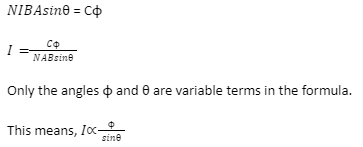A galvanometer is an electrical device used to measure the small value of currents. The galvanometer has gone through numerous versions since its invention in the 1800s. Mirror galvanometers, Tangent galvanometers, and Astatic galvanometers are some types of galvanometers being used currently. But the moving coil galvanometer is more commonly used than all other galvanometers. While improved versions of Galvanometers have been developed, including ammeters, they have been crucial to the development of science and technology in various fields.
Working Principle of A Moving Coil Galvanometer
Moving coil galvanometers work on the principle that a current-carrying coil experiences torque when placed in a magnetic field. As the electric current is passed through the coil, a torque acts on it, which deflects the coil. The deflection of the coil is measured using a scale, and the deflection is directly proportional to the amount of the current passed through the coil. The greater the amount of current, the greater the torque and the deflection. It also produces a higher reading on the scale.
Types of Moving Coil Galvanometers
There are mainly two types of moving coil galvanometers:
- Pivoted coil galvanometers: It consists of a rectangular coil rotating freely on a vertical axis between a horseshoe magnet.
- Suspended coil galvanometers: It consists of a rectangular coil suspended between the two poles of a magnet from a movable torsion head.
Construction of A Moving Coil Galvanometer
A moving coil galvanometer is made up of a rectangular coil with multiple turns coiled on a metallic frame. It is usually made of fine copper wire that is sparsely insulated.
In a suspended coil galvanometer, the coil may be suspended in a uniform radial magnetic field by a strip of phosphor-bronze coupled to an adjustable torsion head. The coil must be suspended in a conductive material with a low torsional constant. A cylindrical soft iron core is symmetrically positioned within the coil to increase the magnetic field’s strength and make it radial. The lower part of the coil is connected to a phosphor-bronze spring. The spring gives a counter torque that balances the magnetic force.
In a pivoted coil galvanometer, the coil is allowed to rotate freely between the magnetic poles.
Working of A Moving Coil Galvanometer
The objective of the moving coil galvanometer is to measure the amount of the current passed through the coil. The current is passed through a coil that has n turns. Due to the magnetic field produced by the current coil, the torque that acts on the coil can be found using the following formula:
=NIBAsin
Where,
N is the number of turns of the coil
I is the amount of the current passed through the coil to be measured
B is the magnetic field
is the torque that acts on the coil
A is the area of the coil
is the angle subtended between the area vector and the magnetic field
The above formula can also written as;
=MBsin
M=NIA
M is the magnetic moment
The direction of the magnetic moment is found by curling the right-hand fingers in the current direction. The thumb should be in the direction of the magnetic moment. When the coil rotates, the fine wire and spring start twisting, due to which a restoring torque is developed in both the spring and the fine wire. The restoring force is directly proportional to the amount of current passed and the rotation of the coil.
As the coil starts rotating, the restoring torque keeps on increasing. The point at which the applied torque is balanced by the restoring torque is when the coil stops rotating. The angle at which it stops rotating is denoted by . This is the equilibrium condition.
At this stage, applied torque = restoring torque

The electric current produced depends upon both and .
Sensitivity of a galvanometer
Sensitivity is defined as the response obtained in the form of deflection when the current is passed through the coil. A galvanometer that shows a large deflection from a small amount of current is highly sensitive.
There are two types of sensitivity:
Current sensitivity

Where,
N is the no of turns on the coil
I is the amount of the current passed through the coil to be measured
B is the magnetic field
A is the area of the coil
C is the restoring constant
To increase the current sensitivity, we can increase the number of turns of the coil, the area of the coil or decrease the value of the constant by using a bronze phosphor quartz wire.
Voltage sensitivity
It is defined as the ratio of the deflection and amount of voltage.

By modifying the galvanometer, the voltage can also be measured. The galvanometer is highly sensitive when a small voltage shows a higher deflection. To increase the voltage sensitivity, we can increase the number of turns and area of the coil or decrease the resistance value.
Conclusion
A galvanometer is a device used to measure and detect small currents. Currents in milliamperes can be measured with the help of a galvanometer. The moving coil galvanometer is more common than all other types of galvanometers. Moving coil galvanometers work on the principle of torque produced on a current loop placed in a magnetic field. They are extremely important in many applications in science and technology.
 Profile
Profile Settings
Settings Refer your friends
Refer your friends Sign out
Sign out




